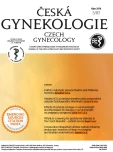Pelvic actinomycosis and IUD
Authors:
B. Sehnal 1; J. Beneš 2; Z. Kolářová 1; M. Mojhová 1; Michal Zikán 1
Authors‘ workplace:
Onkogynekologické centrum, Gynekologicko-porodnická klinika Nemocnice Na Bulovce a 1. LF UK, Praha, doc. MUDr. M. Zikán, Ph. D.
1; Klinika infekčních, parazitárních a tropických nemocí Nemocnice Na Bulovce a 3. LF UK, Praha, přednosta prof. MUDr. J. Beneš, CSc.
2
Published in:
Ceska Gynekol 2018; 83(5): 386-390
Category:
Overview
Objective:
To summarize knowledge about the management in women with proven actinomyces in uterine cervix and inserted intrauterine device (IUD).
Design:
An overall review.
Results:
Actinomycosis is an uncommon but important subacute or chronic infection caused by anaerobic or microaerophilic bacteria, mainly within the Actinomyces genus. Actinomycosis can affect various organs and tissues in the human body, often manifesting draining sinuses, abscess formation and fibrosis. The pelvic form in women is the most common in the developed countries. Long-duration treatment with antibiotics can be completely effective even in cases of heavy disease. Although pelvic actinomycosis is predominantly associated with the longstanding use of intrauterine device, the risk of future symptomatic infection is extremly low even in women with a cervical Pap smear positive for actinomyces-like organisms (ALO). Therefore the identification of actinomycetes by cytology after cervical Pap smears is not diagnostic nor predictive of any disease because the actinomycetes normally reside in the female genital tract. In the absence of symptoms, patients with ALO on a Pap test do not need antimicrobial treatment or IUD removal. Nevertheless, women choosing an IUD for contraception should know that there is very low risk of developing the infection in later years after insertion.
Conclusion:
The sources of literature conclude that removal of the intrauterine device in a patients with a positive ALO in the uterine cervix is not necessary and antibiotics treatment is not required. However, IUD must be changed at least every five years in order to limit the risk of the development of pelvic actinomycosis.
Keywords:
pelvic actinomycosis, IUD, actinomyces, actinomyces-like organisms, ALO, sulfur granules
Sources
1. Beneš, J., a kol. Aktinomykóza in Infekční lékařství, 1. vyd. Praha: Galén, 2009. s. 267–268.
2. Beneš, J. Antibiotika: systematika, vlastnosti, použití, 1. vyd. Praha: Grada, 2018, s. 112–142, 539–564.
3. Boyanova, L., Kolarov, R., Mateva, L., et al. Actinomycosis: a frequently forgotten disease. Future Microbiol, 2015, 10(4), p. 613–628.
4. Brenner, R., Gehring, S. Pelvic actinomycosis in the prescence of an endocervical contraceptive device. Obstet Gynecol, 1967, 29, p. 71–73.
5. Caylay, J., Fotherby, K., Guillebaud, J., et al. Recommendations for clinical practice: Actinomyces-like organisms and intrauterine contraceptives. Br J Fam Plan, 1998, 23, p. 137–138.
6. Curtis, EM., Pine, L. Actinomycetes in the vaginas of women with and without intrauterine contraceptive devices. Am J Obstet Gynecol, 1981, 140, p. 880–884.
7. Fiorino, AS. Intrauterine contraceptive device-associated actinomycotic abscess and Actinomyces detection on cervical smear. Obstet Gynecol, 1996, 87, p. 142–149.
8. Kolařík, D., Halaška, M., Feyereisl, J. Repetitorium gynekologie, 1. vyd. Praha: Maxdorf, 2011, s. 548.
9. Lippes, J. Pelvic actinomycosis: a review and preliminary look at prevalence. Am J Obstet Gynecol, 1999, 180, p. 265–269.
10. Marret, H., Wagner, N., Ouldamer, L., et al. Pelvic actinomycosis: just think of it. Gynecol Obstet Fertil, 2010 38(5), p. 307–312.
11. Mašata, J., a kol. Aktinomykóza. In Infekce v gynekologii, 3. vyd. Praha: Maxdof, 2017, s. 163–167.
12. Matsuda, K., Nakajima, H., Khan, KN., et al. Preoperative diagnosis of pelvic actinomycosis by clinical cytology. Int J Womens Health, 2012, 4, p. 527–533.
13. Perez-Lopez, FR., Tobajas, JJ., Chedraui, P. Female pelvic actinomycosis and intrauterine contraceptive devices. Open Access J Contracept, 2010, 1, p. 35–38.
14. Persson, E., Holmberg, K. A longitudinal study of Actinimyces israelii in the female genital tract. Acta Obstet Gynecol Scand, 1984, 63, p. 207–216.
15. Persson, E., Holmberg, K. Clinical evaluation of precipitin tests for genital actinomycosis. J Clin Microbiol, 1984, 20, p. 917–922.
16. Persson, E. Genital actinomycosis and Actinomyces israelii in the female genital tract. Adv Contracept, 1987, 3, p. 115–123.
17. Petitti, DB., Yamamoto, D., Morgenstern, N. Factors associated with actinomyces-like organisms on Papanicolaou smear in users of intrauterine contraceptive devices. Am J Obstet Gynecol, 1983, 145, p. 338–341.
18. Petroušová, L., Rožnovský, L., Hrbač, T., Jančová, J. Aktinomykóza mozku – kazuistiky. Čes Slov Neurol, 2009, 72, 105(3), s. 270–273.
19. Schiffer, MA., Elguezabal, A., Sultana, M., Allen, AC. Actinomycosis infections associated with intrauterine contraceptive devices. Obstet Gynecol, 1975, 45, p. 67–72.
20. Thiery, M., Claeys, G., Mrozowski, B., et al. Significance of colonization of the lower female genital tract with Actinomyces israelii. IRCS Med Sci, 1986, 14, p. 292–293.
21. Valicenti, J., Pappas, A., Graber, C., et al. Detection and prevalence of IUD-associated actinomyces colonisation and related morbidity. JAMA, 1982, 247, p. 1149–1152.
22. Valour, F., Sénéchal, A., Dupieux, C., et al. Actinomycosis: etiology, clinical features, diagnosis, treatment, and management. Infect Drug Resist, 2014, 7, p. 183–197.
23. Westhoff, C. IUDs and colonization or infection with Actinomyces. Contraception, 2007, 75(6 Suppl.), p. S48–50.
24. Zikán, M. Volba vhodné bioptické metody u primárně inoperabilního nebo recidivujícího zhoubného nádoru a metodika bioptického odběru. Čes Gynek, 2014, 79(6), s. 487–490.
Labels
Paediatric gynaecology Gynaecology and obstetrics Reproduction medicineArticle was published in
Czech Gynaecology

2018 Issue 5
Most read in this issue
- HCG level after embryo transfer as a prognostic indicator of pregnancy finished with delivery
- Vaginal microbiome
- Pelvic actinomycosis and IUD
- Eating disorders in pregnancy
